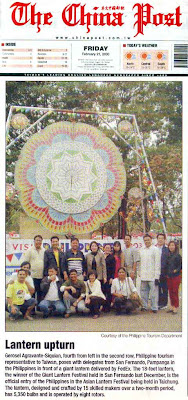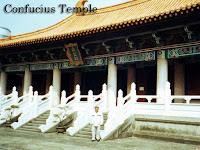 How can one forget the date we left for Taiwan. It was February 14, 2003. The City Government of San Fernando was being sent by the Department of Tourism to represent the country in the 2003 Taiwan Lantern Festival which was held in Taichung. I had previously been to Taiwan when I was five but we only went around Taipei. So this was my first time to get out of the capital city. But time was limited since although we were there for almost two weeks, most of our time was at the festival and meeting with local officials.
How can one forget the date we left for Taiwan. It was February 14, 2003. The City Government of San Fernando was being sent by the Department of Tourism to represent the country in the 2003 Taiwan Lantern Festival which was held in Taichung. I had previously been to Taiwan when I was five but we only went around Taipei. So this was my first time to get out of the capital city. But time was limited since although we were there for almost two weeks, most of our time was at the festival and meeting with local officials.It was a late night Philippine Airlines flight since I remember, our passports were stamped in Taipei on the 15th. We were met by the Tourism Attache who accompanied us on the two-hour bus to Taichung, Taiwan's culture city. The bus ride was very comfortable since the chairs were really big. It was like sleeping in your own living room. When we arrived in Taichung we all went straight to bed.
Most of our time that day was spent at the Taichung branch of the Manila Economic and Cultural Office (MECO), our de facto embassy in Taiwan. That night was the opening of the festival. We had passes but didn't get to use them since we were busy preparing the San Fernando giant lantern.
 Anyway, when our work was done, I checked if I could still catch the program. But when I got close to the stage, President Chen Shui-bian was about to leave. I was just about a meter or two away but because of tight security, I wasn't able to have a photo taken with him like I usually do when I get the chance to meet heads of state . Who wouldn't? Oh well!
Anyway, when our work was done, I checked if I could still catch the program. But when I got close to the stage, President Chen Shui-bian was about to leave. I was just about a meter or two away but because of tight security, I wasn't able to have a photo taken with him like I usually do when I get the chance to meet heads of state . Who wouldn't? Oh well!On the right is the main lantern that was lit by President Chen. I remember that the NT$10 million (US$287,356) spent by Chunghua Telecom to produce this 20-meter lantern was the talk of the town during the festival.
 We only got to go around Taichung on the 17th and 18th. I remember walking around Taichung Park, also known as Zhong Shan Park. Its main attraction is Jih-Yueh Lake which was originally a natural pond. After years of human modifications, it now covers an area of about 13,500 square meters. In the middle of the lake is a pavillion built in 1908 to commemorate the completion of the north-south railway when the island was still under Japanese occupation. This pavilion has become an important symbol of the city.
We only got to go around Taichung on the 17th and 18th. I remember walking around Taichung Park, also known as Zhong Shan Park. Its main attraction is Jih-Yueh Lake which was originally a natural pond. After years of human modifications, it now covers an area of about 13,500 square meters. In the middle of the lake is a pavillion built in 1908 to commemorate the completion of the north-south railway when the island was still under Japanese occupation. This pavilion has become an important symbol of the city. It was while reading on the Japanese rule in Taiwan that I found out that the Republica Filipina was not the first Asian republic as some would claim, but was predated by the Republic of Formosa (May 24, 1895) and the Republic of Ezo in Japan (December 25, 1868) among others. In fact, according to Wikipedia, the first republics in Asia are Vaishali, Licchavi and Vajji all established in India circa 600 B.C.
It was while reading on the Japanese rule in Taiwan that I found out that the Republica Filipina was not the first Asian republic as some would claim, but was predated by the Republic of Formosa (May 24, 1895) and the Republic of Ezo in Japan (December 25, 1868) among others. In fact, according to Wikipedia, the first republics in Asia are Vaishali, Licchavi and Vajji all established in India circa 600 B.C. The next day, we visited the Confucius Temple. According to the Taichung website "Taichung's peaceful Confucius Temple features impressive, rectangular Sung Dynasty-style structures, surrounded by spacious courtyards and a garden. The buildings and grounds are usually quiet and near-deserted, giving the temple a relaxing, meditative air. Once a year, during Confucius' birthday (Teachers' Day), the temple comes to life for a dawn ceremony featuring processions of marchers and musicians clad in traditional Chinese imperial court costumes, government officials and hundreds of spectators." Beside it is the Martyrs Shrine. But we weren't able to go inside since it's closed on weekdays.
The next day, we visited the Confucius Temple. According to the Taichung website "Taichung's peaceful Confucius Temple features impressive, rectangular Sung Dynasty-style structures, surrounded by spacious courtyards and a garden. The buildings and grounds are usually quiet and near-deserted, giving the temple a relaxing, meditative air. Once a year, during Confucius' birthday (Teachers' Day), the temple comes to life for a dawn ceremony featuring processions of marchers and musicians clad in traditional Chinese imperial court costumes, government officials and hundreds of spectators." Beside it is the Martyrs Shrine. But we weren't able to go inside since it's closed on weekdays. We also got to visit the Paochueh Temple, a Buddhist temple in the northern edge of the city which is known for its big Buddha statue. The 88-foot gold statue is a big-bellied, happy Buddha known as Maitreya. Below it is an inscription which translates "Happiness to All."
We also got to visit the Paochueh Temple, a Buddhist temple in the northern edge of the city which is known for its big Buddha statue. The 88-foot gold statue is a big-bellied, happy Buddha known as Maitreya. Below it is an inscription which translates "Happiness to All."The temple complex is a quiet and secluded place where one can reflect and meditate. The main shrine hall, with a striking blue glazed roof, was built in 1928 and houses three Buddha images protected by a row of fierce guardians.
 That afternoon, we also made a courtesy call to Mr. Chen Tien-Wen, the Vice Speaker of the Taichung City Council at the historic Taichung City Hall. It was commissioned in 1912 as the Taichung State Building by the Japanese colonial government. This wood and re-inforced brick structure was completed in 1924 and is considered one of the most elaborate and ornate buildings of the Japanese colonial period in Taiwan.
That afternoon, we also made a courtesy call to Mr. Chen Tien-Wen, the Vice Speaker of the Taichung City Council at the historic Taichung City Hall. It was commissioned in 1912 as the Taichung State Building by the Japanese colonial government. This wood and re-inforced brick structure was completed in 1924 and is considered one of the most elaborate and ornate buildings of the Japanese colonial period in Taiwan.That's it for Taichung. Up next is the day trip to the mountains in Nantou County we did the day after.
Heritage watch
■ Chinese boat loaded with stuffed sea turtles released
■ Legal eagles to help prosecute Tubbataha reef poachers
■ Legal team formed to help prosecute Chinese poachers
■ Chinese envoy’s letter led to suspected poachers’ release
■ Chinese gov’t pressed RP to free Tubbataha poachers
This is a very sad issue for the Philippines. It just shows how weak our government is in protecting our natural heritage. It also shows how other nations condone the illegal acts of their citizens.
■ Lost but not forgotten lighthouse
■ Pila townsfolk preserve heritage town
Here is some good news for everyone. I hope other localities follow Pila's example.
■ Historic church, houses fill Laguna town’s coffers
■ Restoring Dagupan’s most treasured heritage

[...] the pleasure of travelling can't be compared to anything and when i check out this site, i could be travelling with it. it's the web, travelling could just be one click away. [...]
ReplyDelete[...] A traveler from the Philippines visits Taichung, Cultural City [...]
ReplyDelete